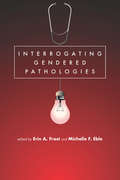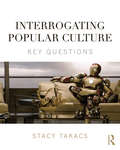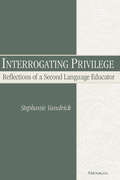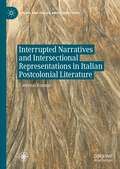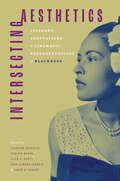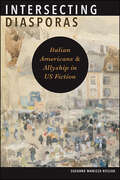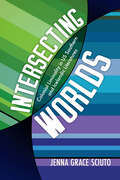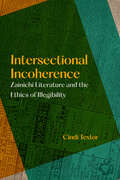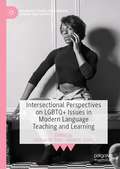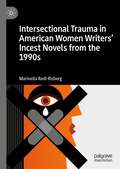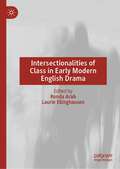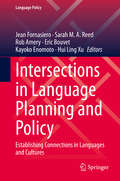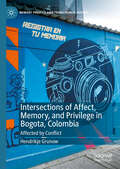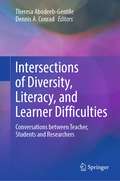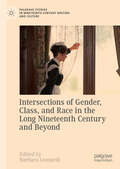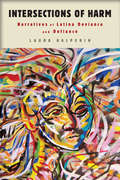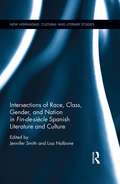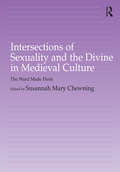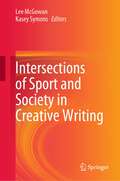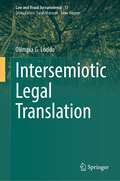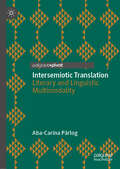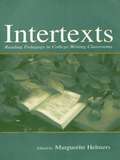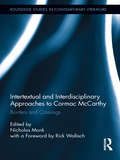- Table View
- List View
Interrogating Gendered Pathologies
by Erin A Frost Michelle F. EbleInterrogating Gendered Pathologies points out and critiques unjust patterns of pathology. Erin A. Frost and Michelle F. Eble assemble a transdisciplinary approach from/to technologies, rhetorics, philosophies, epistemologies, and biomedical data to consider the effects of biomedicine’s gendered norms on people’s lives. Using a range of complementary and intersectional theoretical approaches, contributors ask questions about rhetoric’s role in healthcare and how it differs depending on patient embodiment and the ways nonnormative bodies are pathologized. These chapters engage common narratives about the ways in which gender in healthcare is secondary and highlights the stories of people who have battled to prioritize their own bodies through extraordinary difficulties. Employing a multiplicity of voices, the book represents a number of different perspectives on what it might look like to return health and medical data to embodied experience, to consider the effects of gendered and intersectional biomedical norms on lived realities, and to subvert the power of institutions in ways that move us toward biomedical justice. This collection contributes to the burgeoning field of health and medical rhetorics by rhetorically and theoretically intervening in what are often seen as objective and neutral decisions related to the body and to scientific and medical data about bodies. Interrogating Gendered Pathologies will be of interest to feminist scholars in the field of rhetoric and writing studies, specifically those in the rhetorics of health and medicine, as well as scholars of technical communication, feminist studies, gender studies, technoscience studies, and bioethics. Contributors: Leslie Anglesey, Mary Assad, Beth Boser, Lillian Campbell, Marleah Dean, Lori Beth De Hertogh, Leandra Hernandez, Elizabeth Horn-Walker, Caitlin Leach, Jordan Liz, Miriam Mara, Cathryn Molloy, Kerri Morris, Maria Novotny, Sage Perdue, Colleen Reilly
Interrogating Popular Culture: Key Questions
by Stacy TakacsInterrogating Popular Culture: Key Questions offers an accessible introduction to the study of popular culture, both historical and contemporary. Beginning from the assumption that cultural systems are dynamic, contradictory, and hard to pin down, Stacy Takacs explores the field through a survey of important questions, addressing: Definitions: What is popular culture? How has it developed over time? What functions does it serve? Method: What is a proper object of study? How should we analyze and interpret popular texts and practices? Influence: How does popular culture relate to social power and control? Identity and disposition: How do we relate to popular culture? How does it move and connect us? Environment: How does popular culture shape the ways we think, feel and act in the world? Illustrated with a wide variety of case studies, covering everything from medieval spectacle to reality TV, sports fandom and Youtube, Interrogating Popular Culture gives students a theoretically rich analytical toolkit for understanding the complex relationship between popular culture, identity and society.
Interrogating Privilege: Reflections of a Second Language Educator
by Stephanie VandrickInterrogating Privilege is a welcome combination of personal essays and academic research, blending theory, analysis, and narrative to explore the function and consequences of privilege in second language education. While teachers’ focus on the learning process and class goals are quite important, there is not enough attention paid to the types of privilege—or lack thereof—that individuals bring to the classroom. Through chapters that can either stand alone or be read together, with topics such as gender, age, and colonialism (the author is the daughter of missionary parents) in second language teaching, this book seeks to address the experiences of teachers, scholars, and students as “whole persons” and to observe the workings of identity and privilege in the educational setting.
Interrogating the Communicative Power of Whiteness (Routledge Research in Communication Studies)
by Dawn Marie McIntosh Dreama G. Moon Thomas K. NakayamaThe field of communication offers the study of whiteness a focus on discourse which directs its attention to the everyday experiences of whiteness through regimes of truth, embodied acts, and the deconstruction of mediated texts. This book takes an intersectional approach to whiteness studies, researching whiteness through rhetorical analysis, qualitative research, performance studies, and interpretive research. More specifically the chapters deconstruct the communicative power of whiteness in the context of the United States, but with discussion of the implications of this power internationally, by taking on relevant and current topics such as terrorism, post-colonial challenges, white fragility at the national level, the emergence of colorblind discourse as a pro-white discursive strategy, the relationship of people of color with and through whiteness, as well as multifaceted identities that intersect with whiteness, including religion, masculinity and femininity, social class, ability, and sexuality.
Interrupted Narratives and Intersectional Representations in Italian Postcolonial Literature (Italian and Italian American Studies)
by Caterina RomeoThis book argues for the importance of adopting a postcolonial perspective in analysing contemporary Italian culture and literature. Originally published in Italian in 2018 as Riscrivere la nazione: La letteratura italiana postcoloniale, this new English translation brings to light the connections between the present, the colonial past and the great historical waves of international and intranational migration. By doing so, the book shows how a sense of Italian national identity emerged, at least in part, as the result of different migrations and why there is such a strong resistance in Italy to extending the privilege of italianità, or Italianness, to those who have arrived on Italian soil in recent years. Exploring over 100 texts written by migrant and second-generation writers, the book takes an intersectional approach to understanding gender and race in Italian identity. It connects these literary and cultural contexts to the Italian colonial past, while also looking outwards to a more diffuse postcolonial condition in Europe.
Intersecting Aesthetics: Literary Adaptations and Cinematic Representations of Blackness
by Charlene Regester, Cynthia Baron, Ellen C. Scott, Terri Simone Francis, and Robin G. VanderContributions by Cynthia Baron, Elizabeth Binggeli, Kimberly Nichele Brown, Priscilla Layne, Eric Pierson, Charlene Regester, Ellen C. Scott, Tanya L. Shields, and Judith E. Smith Intersecting Aesthetics: Literary Adaptations and Cinematic Representations of Blackness illuminates cultural and material trends that shaped Black film adaptations during the twentieth century. Contributors to this collection reveal how Black literary and filmic texts are sites of negotiation between dominant and resistant perspectives. Their work ultimately explores the effects racial perspectives have on film adaptations and how race-inflected cultural norms have influenced studio and independent film depictions. Several chapters analyze how self-censorship and industry censorship affect Black writing and the adaptations of Black stories in early to mid-twentieth-century America. Using archival material, contributors demonstrate the ways commercial obstacles have led Black writers and white-dominated studios to mask Black experiences. Other chapters document instances in which Black writers and directors navigate cultural norms and material realities to realize their visions in literary works, independent films, and studio productions. Through uncovering patterns in Black film adaptations, Intersecting Aesthetics reveals themes, aesthetic strategies, and cultural dynamics that rightfully belong to accounts of film adaptation. The volume considers travelogue and autobiography sources along with the fiction of Black authors H. G. de Lisser, Richard Wright, Ann Petry, Frank Yerby, and Walter Mosley. Contributors examine independent films The Love Wanga (1936) and The Devil’s Daughter (1939); Melvin Van Peebles's first feature, The Story of a Three Day Pass (1967); and the Senegalese film Karmen Geï (2001). They also explore studio-era films In This Our Life (1942), The Foxes of Harrow (1947), Lydia Bailey (1952), The Golden Hawk (1952), and The Saracen Blade (1954) and post-studio films The Learning Tree (1969), Shaft (1971), Lady Sings the Blues (1972), and Devil in a Blue Dress (1995).
Intersecting Diasporas: Italian Americans and Allyship in US Fiction (SUNY series in Italian/American Culture)
by Suzanne Manizza RoszakIntersecting Diasporas examines literary expressions of allyship between Italian America and other diasporic communities in modern and contemporary US fiction. Rewriting the Anglo-American genre of the "Italian novel," authors like James Baldwin, Bernard Malamud, Carolina De Robertis, and Chang-rae Lee have disrupted misconceptions of Italian and Italian American identity while confronting Italians' own complicity with white racism. Likewise, Italian American authors from John Fante to Tina De Rosa have written in solidarity with Black, Chicanx, Filipinx, Jewish, Romani, and Irish diasporic communities on US shores, unsettling stereotypes and dissecting Italian America's history of flawed allyship across diasporas. Suzanne Manizza Roszak traces these gestures of literary solidarity; considers how they relate to the writers' critiques of toxic masculinity, antiqueerness, and socioeconomic injustice; and proposes interdiasporic allyship as a practice of reconciliation and healing.
Intersecting Worlds: Colonial Liminality in US Southern and Icelandic Literatures
by Jenna Grace SciutoIntersecting Worlds: Colonial Liminality in US Southern and Icelandic Literatures recalibrates readings of US southern and American writers by exploring comparable depictions of race, colonialism, Whiteness, gender, and sexuality in Icelandic literature. This book explores the liminality, ambiguity, and general unease that result when postcolonial theories are applied to both Iceland and the US South. It investigates the parallels and also the limitations to such comparisons with the labels and binaries created to represent colonial dynamics flattening the complex positionings of Iceland and the US South. Iceland, an independent nation since 1944, has a complex colonial history. As a former dependency of Denmark that endured a US military presence from 1941 to 2006, Iceland’s global positioning invites comparisons to formerly colonized spaces. At the same time, Iceland’s history and geopolitical location differ from other colonized nations, which were subject to brutal violence and dehumanizing practices. This comparative project investigates Iceland’s colonial liminality and draws connections to the colonial ambiguity of the US South, depicted as colonized by the federal government during Reconstruction and the site of the colonization of the Black population through slavery and its later iterations.Exploring the work of US southern writers, like William Faulkner, Gayl Jones, Jean Toomer, and Carson McCullers, alongside twentieth-century Icelandic novelists, including Halldór Laxness, Svava Jakobsdóttir, Guðbergur Bergsson, and Fríða Áslaug Sigurðardóttir, on both thematic and aesthetic levels reveals much about each region’s history and the complexity of colonial dynamics. Intersecting Worlds centers layers of Whiteness in both national and transnational contexts, challenges ideas of Nordic and US southern exceptionalism, and exposes the complex impacts of colonialism in the Global North and the Global South, as depicted in twentieth-century literature.
Intersectional Incoherence: Zainichi Literature and the Ethics of Illegibility (Global Korea #5)
by Cindi TextorA free ebook version of this title is available through Luminos, University of California Press's Open Access publishing program. Visit www.luminosoa.org to learn more.Intersectional Incoherence stages an encounter between the critical discourse on intersectionality and texts produced by Korean subjects of the Japanese empire and their postwar descendants in Japan, known as Zainichi Koreans. Arguing for intersectionality as a reading method rather than strictly a tool of social analysis, Cindi Textor reads moments of illegibility and incoherent language in these texts as a product of the pressures on Zainichi Koreans and their literature to represent both Korean difference from and affinity with Japan. Rejecting linguistic norms and representational imperatives of identity categories, Textor instead demands that the reader grapple with the silent, absent, illegible, or unintelligible. Engaging with the incoherent, she argues, allows for a more ethical approach to texts, subjects, and communities that resist representation within existing paradigms.
Intersectional Perspectives on LGBTQ+ Issues in Modern Language Teaching and Learning (Palgrave Studies in Language, Gender and Sexuality)
by Joshua M. Paiz James E. CodaThis edited book examines how sexuality and sexual identity intersect and interact with other identities and subjectivities – including but not limited to race, religion, gender, social class, ableness, and immigrant or refugee status – to form reinforcing webs of privilege and oppression that can have significant implications for language teaching and learning processes. The authors explore how these intersections may influence the teaching of different languages and how pedagogies can be devised to increase equitable access to language learning spaces. They seek to open the conversation on intersectional issues as they relate to sexuality and language teaching and learning, and provide a conversational space where readers can engage with the notion of intersectionality. This book will be of interest to students and scholars of applied linguistics and language education, gender and LGBTQ+ studies, and sociolinguistics, outlining possible future directions for intersectional research.
Intersectional Trauma in American Women Writers' Incest Novels from the 1990s
by Marinella Rodi-RisbergThis book explores the intersections of sexualized, gendered, and racialized traumas in five US novels about father-daughter incest from the 1990s. It examines how incest can be connected to wider past and present structural oppression and institutional abuse, and what fiction looks like that testifies against and references a historical background of slavery, poverty, settler colonialism, annexation, and immigration. Investigating the means of resistance used against attempts at silencing and denial in these texts, the book also shows how contemporary women’s novels can propose social change. Overall, this study uniquely argues that the individual trauma of incest in these texts must be understood in relation to histories of and present collective wounding against marginalized communities. By sitting at the intersections between trauma theory and US third world feminism, it allows for theory to meet literary activism.
Intersectionalities of Class in Early Modern English Drama
by Ronda Arab Laurie EllinghausenDefining class broadly as an identity categorization based on status, wealth, family, bloodlines, and occupation, Intersectionalities of Class in Early Modern English Drama e xplores class as a complicated, contingent phenomenon modified by a wider range of social categories apart from those defining terms, including, but not limited to, race, gender, religion, and sexuality. This collection of essays – featuring a range of international contributors – explores a broad range of questions about the intersectional factors influencing class status in early modern England, including how cultural behaviors and non-class social categories affected status and social mobility, in what ways hegemonies of elite prerogatives could be disrupted or entrenched by the myriad of intersectional factors that informed social identity, and how class position informed the embodied experience and expression of affect, gender, sexuality, and race as well as relationships to place, space, land, and the natural and civic worlds.
Intersections in Language Planning and Policy: Establishing Connections in Languages and Cultures (Language Policy #23)
by Hui Ling Xu Jean Fornasiero Sarah M. A. Reed Rob Amery Eric Bouvet Kayoko EnomotoThis volume encompasses the range of issues encountered by language scholars who teach and research in departments of languages and cultures within the higher education system, predominantly in Australia, but touching other universities worldwide. Related studies on language planning, methodology or pedagogy have focused on one or more of these same issues, but rarely on their totality. Intersections as a metaphor running discreetly through the essays in this volume, connects them all to a lived reality. The field of languages and cultures, as it is practised and reflected upon in Australian universities, is essentially an interdisciplinary and interconnecting space - one in which linguistic and disciplinary diversities meet and join forces, rather than collide or disperse along different pathways. The international and local studies featured here focus on language planning, new pedagogies and language reclamation and link to meeting points and commonalities. They show that language scholars are increasingly finding themselves on common ground as they tackle issues of policy and practice affecting their field, whether within their institutions, within the tertiary system, or within the framework of government policy.
Intersections of Affect, Memory, and Privilege in Bogota, Colombia: Affected by Conflict (Memory Politics and Transitional Justice)
by Hendrikje GrunowThis book explores the intersections of affect, memory and privilege among Bogota’s upper middle class. Combining approaches from memory studies, anthropology, feminist and affect theory, this work is concerned with the implications for the present and potential futures contained in affective encounters. It is structured along four affects describing the social, spatial, historical and political aspects of ‘being affected’ by the Colombian conflict. After showing how the Colombian conflict is rooted in specific affective relationships to land, disappointment and crushed hopes in the context of various peace negotiations are portrayed as the central experiences nurturing a sense of a doubling or re-experiencing of past emotions. Then, a specifically upper-middle class emotional habitus and its implication for the social connections to people more directly affected by the conflict are outlined, and peace as an upper middle-class affect is revealed as a privilege not everyone deserves.
Intersections of Diversity, Literacy, and Learner Difficulties: Conversations between Teacher, Students and Researchers
by Theresa Abodeeb-Gentile Dennis A. ConradThis book invites readers to challenge, corroborate, and add to the discourse on more inclusive pedagogical practice. Presenting theoretically and empirically informed research, it highlights potential considerations regarding the intersections of diversity, literacy, and learner difficulties. These three areas provide a stage where opposing paradigms often pose challenges for educators and create unnecessary barriers to providing the best education for all learners. These barriers might reveal how students are positioned through a deficit lens rather than one that recognizes individual differences and how these learner differences sometimes result in labels or put students at increased risk of encountering difficulties. The contributing authors’ goals are to start and sustain a conversation that examines these perspectives and to offer counter-narratives to the deficit lens by recognizing that individual difference does not need to be a barrier to educational access. By examining opportunities for more inclusive educational success, this book encourages discourse among key stakeholders; further, it goes beyond problematizing to offer new avenues for optimal learning and inclusive pedagogy across multiple contexts.
Intersections of Gender, Class, and Race in the Long Nineteenth Century and Beyond (Palgrave Studies In Nineteenth-century Writing And Culture )
by Barbara LeonardiThis book explores the intersections of gender with class and race in the construction of national and imperial ideologies and their fluid transformation from the Romantic to the Victorian period and beyond, exposing how these cultural constructions are deeply entangled with the family metaphor. For example, by examining the re-signification of the “angel in the house” and the deviant woman in the context of unstable or contingent masculinities and across discourses of class and nation, the volume contributes to a more nuanced understanding of British cultural constructions in the long nineteenth century. The central idea is to unearth the historical roots of the family metaphor in the construction of national and imperial ideologies, and to uncover the interests served by its specific discursive formation. The book explores both male and female stereotypes, enabling a more perceptive comparison, enriched with a nuanced reflection on the construction and social function of class.
Intersections of Harm
by Laura HalperinIn this innovative new study, Laura Halperin examines literary representations of harm inflicted on Latinas' minds and bodies, and on the places Latinas inhabit, but she also explores how hope can be found amid so much harm. Analyzing contemporary memoirs and novels by Irene Vilar, Loida Maritza Pérez, Ana Castillo, Cristina García, and Julia Alvarez, she argues that the individual harm experienced by Latinas needs to be understood in relation to the collective histories of aggression against their communities. Intersections of Harm is more than just a nuanced examination of the intersections among race, ethnicity, class, gender, and sexuality. It also explores the intersections of deviance and defiance, individual and collective, and mind, body, and place. Halperin proposes that, ironically, the harmful ascriptions of Latina deviance are tied to the hopeful expressions of Latina defiance. While the Latina protagonists' defiance feeds into the labels of deviance imposed on them, it also fuels the protagonists' ability to resist such harmful treatment. In this analysis, Halperin broadens the parameters of literary studies of female madness, as she compels us to shift our understanding of where madness lies. She insists that the madness readily attributed to individual Latinas is entwined with the madness of institutional structures of oppression, and she maintains that psychological harm is bound together with physical and geopolitical harm. In her pan-Latina study, Halperin shows how each writer's work emerges from a unique set of locales and histories, but she also traces a network of connections among them. Bringing together concepts from feminism, postcolonialism, illness studies, and ecocriticism, Intersections of Harm opens up exciting new avenues for Latina/o studies.
Intersections of Race, Class, Gender, and Nation in Fin-de-siècle Spanish Literature and Culture (New Hispanisms: Cultural and Literary Studies)
by Jennifer Smith Lisa NalboneThis volume focuses on intersections of race, class, gender, and nation in the formation of the fin-de-siècle Spanish and Spanish colonial subject. Despite the wealth of research produced on gender, social class, race, and national identity few studies have focused on how these categories interacted, frequently operating simultaneously to reveal contexts in which dominated groups were dominating and vice versa. Such revelations call into question metanarratives about the exploitation of one group by another and bring to light interlocking systems of identity formation, and consequently oppression, that are difficult to disentangle. The authors included here study this dynamic in a variety of genres and venues, namely the essay, the novel, the short story, theater, and zarzuelas. These essays cover canonical authors such as Benito Pérez Galdós and Emilia Pardo Bazán, and understudied female authors such as Rosario de Acuña and Belén Sárraga. The authors included here study this dynamic in a variety of genres and venues, namely the essay, the novel, the short story, theater, and zarzuelas. The volume builds on recent scholarship on race, class, gender, and nation by focusing specifically on the intersections of these categories, and by studying this dynamic in popular culture, visual culture, and in the works of both canonical and lesser-known authors.
Intersections of Sexuality and the Divine in Medieval Culture: The Word Made Flesh
by Susannah ChewningAs distinct from the many recent collections and studies of medieval literature and culture that have focused on gender and sexuality as their major themes, this collection considers and serves to re-think and re-situate religion and sexuality together. Including 'traditional' works such as Chaucer and the Pearl-poet, as well as less well known and studied texts - such as alchemical texts and the Wohunge group - the contributors here focus on the meeting point of these two often-examined concepts. They seek an understanding of where sex and religion distinguish themselves from one another, and where they do not. This volume locates the Divine and the Erotic within the continuum of experience and devotion that characterize the paradox of the medieval world. Not merely original in their approaches, these authors seek a new vision of how these two inter-connected themes - sexuality and the Divine - meet, connect, distinguish themselves, and merge within medieval life, language, and literature.
Intersections of Sport and Society in Creative Writing
by Lee McGowan Kasey SymonsThis edited collection is positioned at the nexus of sports, society and creative writing. In its explorations of the intersections of sports writing, analysis of literary contributions and examinations of craft, it offers rare consideration of a rich diversity of form in narratives that occur in, and as creative practice. Included in the collection are dynamic academic investigations into football writing and poetry focused on community sporting activities in Afghanistan, to those addressing the intersections of writing and boxing in the reflexive reclamation of the post-trauma self, the absence of women in the rodeo and who and what is represented in our sports shelves. This book breaks new ground in approaches to sport’s role in creative writing and what creative writing can provide in furthering our understanding of sport in society. The works in this edited book draw on a diverse range of methods to interrogate the processes, concepts and liminal spaces through an intersectional array of voices, offering analysis and insight into the application of creative writing knowledge and practice in relation to sport and its impact on wider discipline discussion and research. It is relevant to students and scholars studying and researching creative writing, sports writing, sports studies, cultural studies and sports media studies.
Intersemiotic Legal Translation (Law and Visual Jurisprudence #11)
by Olimpia G. LoddoThe translation of legal documents in today’s globally interconnected world calls for novel approaches to overcoming traditional language barriers. The verbal language used in legal documents can be accompanied or even replaced by various types of semiotic resource, such as symbols, diagrams, and icons, while the advancement of digital tools and the introduction of new technologies offer those drafting contracts and other legal documents access to an ever-expanding toolbox for the translation process.This book makes a significant contribution to the existing literature on legal translation and intersemiotic translation by sharing valuable insights and opening up new avenues of inquiry, fostering further exploration of this evolving domain and enabling practitioners to use these diverse communication tools responsibly and effectively.Given the book’s structured multidisciplinary approach and extensive analyses of the characteristics of intersemiotic legal translation, its potential, and the complexities that arise at the intersection of law, language, and semiotics, it will appeal to legal practitioners, translators, semiotic scholars, and legal philosophers alike.Whether you are a legal professional aiming to expand your expertise, an academic seeking a new research direction, or are simply intrigued by the fascinating interplay of law, language, and semiotics, this book offers a valuable resource that sheds light on the unique dynamics of translating legal concepts using approaches other than traditional verbal communication. As such, it is an essential read for anyone who is interested in the changing landscape of law, language, and translation.
Intersemiotic Perspectives on Emotions: Translating across Signs, Bodies and Values (Creative, Social and Transnational Perspectives on Translation)
by Susan PetrilliThis edited volume explores emotion and its translations through the global world from a variety of different perspectives, as a personal, socio-cultural, ideological, political, and even business investment in the latest phases of globalisation. Emotions are powerful in engaging or disengaging individuals, communities, the masses, peoples and nations with distinct linguistic and cultural backgrounds for good, but especially for evil. All depends on how emotions are interpreted, that is translated in "words" or in "facts", in any case in "signs". Semiotic reflection on emotions and their interpretation/translation is thus of essential importance. An adequate understanding of emotional phenomena and their complexities calls for different views which together reveal and illustrate inconsistencies in our modern life. The contributors argue that an investigation of types of emotional translation – linguistic and non-linguistic, audio-visual, theatrical, literary, racial, legal, architectural, political, and so forth – can contribute to a better understanding of emotions and how they are exploited to engender injustice, unfairness, absurdity in contemporary life. However, emotions can also be exploited and oriented – and this is the intent of our authors – to favour the development of sustainable multicultural societies and facilitate living together. A fantastic reference for students and scholars in translation, semiotics, language and cultural studies around the world.
Intersemiotic Translation: Literary and Linguistic Multimodality
by Aba-Carina PârlogThis book explores the practical aspects of intersemiotic translation, examining how different signs and sign sets can be transposed into different kinds of semiotic forms of reference. Drawing on theories from translation studies, semiotics, philosophy and stylistics, the author seeks to understand what happens when texts are translated from one genre or modality to another, and makes use of examples ranging from written texts to advertising, images, music, painting, photography, and sculpture. She also analyses related topics such as the differences between Romance and Germanic languages, the difficulties that arise when attempts are made to translate figures of speech or elements of authorial style, and how this interdisciplinary field relates to traditional language-based translation. This book will be of interest to students, teachers, translators and researchers working in the fields of translation studies and multimodality in particular.
Intertexts: Reading Pedagogy in College Writing Classrooms
by Marguerite HelmersWhat do we mean when we talk about reading? What does it mean to "teach reading?" What place does reading have in the college writing classroom? Intertexts: Reading Pedagogy in College Writing Classrooms theoretically and practically situates the teaching of reading as a common pedagogical practice in the college writing classroom. As a whole, the book argues for rethinking the separation of reading and writing within the first-year writing classroom--for an expanded notion of reading that is based on finding and creating meaning from a variety of symbolic forms, not just print-based texts but also other forms, such as Web sites and visual images. The chapter authors represent a range of cultural, personal, and rhetorical perspectives, including cultural studies, classical rhetoric, visual rhetoric, electronic literacy, reader response theory, creative writing, and critical theories of literature and literary criticism. This volume, an important contribution to composition studies, is essential reading for researchers, instructors, writing program administrators, and students involved in college writing instruction and literature.
Intertextual and Interdisciplinary Approaches to Cormac McCarthy: Borders and Crossings (Routledge Studies in Contemporary Literature)
by Nicholas Monk Rick WallachThis collection offers a fresh approach to the work of Cormac McCarthy, one of the most important contemporary American authors. Essays focus on his work across the genres and/or in constellation with other writers and artists, presenting not only a different "angle" on the work, but setting him within a broader literary and artistic context. Such an approach offers a view of McCarthy that is strikingly different to previous collections that have dealt with the work in an almost exclusively "single author" and/or "single genre" mode. McCarthy’s novels are increasingly regarded as amongst the most rich, the most complex, and the most insightful of all recent literary responses to prevailing conditions in both the USA and beyond, and this collection recognizes the intertextual and interdisciplinary nature of his work. Contributors draw back the curtain on some of McCarthy’s literary ancestors, revealing and analyzing some of the fiction’s key contemporary intertexts, and showing a complex and previously underestimated hinterland of influence. In addition, they look beyond the novel both to other genres in McCarthy’s oeuvre, and to the way these genres have influenced McCarthy’s writing.
